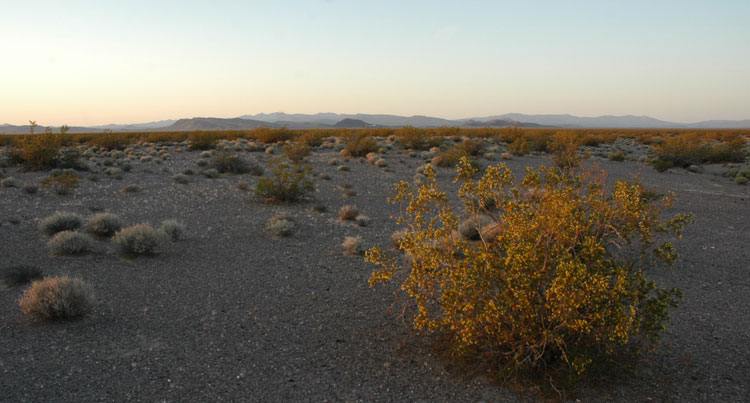Facts Hard to Find at Solar Millennium Open House
May 14, 2009 - Amargosa Valley, Nevada
"It's like a regular ol' coal-burning power plant," explained a company contractor in front of a computer screen showing a chart with fancy moving graphics to a group of locals. The sun heats water to produce steam to turn turbines to generate electricity. A farmer asked why the water needed to be cooled. The answer was efficiency: wet-cooling towers would allow operation to continue on the hottest summer days. But that requires a lot of water...
Solar Millennium LLC, a subsidiary of the German company Solar Millennium AG, has jumped ahead in the race to secure public land for a renewable energy project in the southern Nevada desert.
We attended the open house meeting hosted by Solar Millennium at the Longstreet Casino in Amargosa Valley, Nevada, concerning their plans to build two 268 megawatt (MW) wet-cooled parabolic mirror-trough solar plants in the area. The footprint of the project would be 4,350 acres, which would mean the scraping of a large block of creosote-bursage desert on the edge of town and literally right next to private homes, managed by the Bureau of Land Management (BLM).
Interest was high, and on Saturday a few hundred people showed up to learn about the plan.
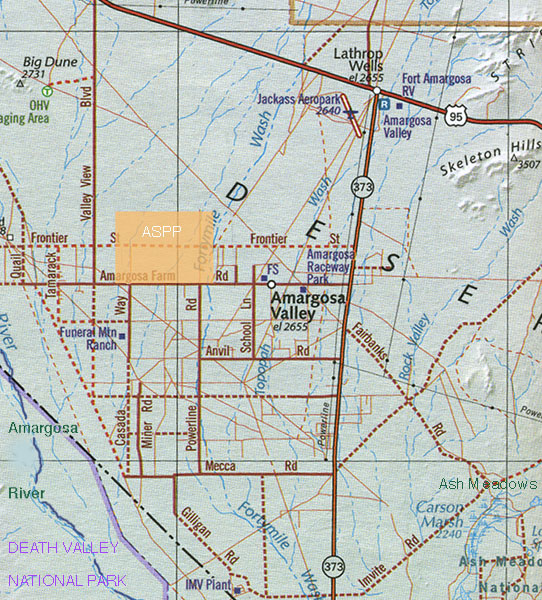
^Map showing Solar Millennium's project site (orange), called 536 MW Amargosa Solar Power Project (ASPP), in Nye County, Nevada, near the border of California. Notice how close it is to Death Valley National Park (lower left) and the Amargosa River, and to Ash Meadows National Wildlife Refuge (lower right), home to many endangered fish and plants.
A first for the U.S., Solar Millennium plans to integrate two large thermal storage tanks into the system to help offset the fact that power is only produced from plants like these when the sun shines. This has dogged renewables such as wind and solar in that they are "peaker" power providers, not "baseload" like coal and natural-gas burning power plants and hydroelectric dams, which provide a smooth flow of electricity into the grid 24 hours a day all year. Baseload is needed to provide power when the air conditioners are going full-strength, or other such loads on the system happen.
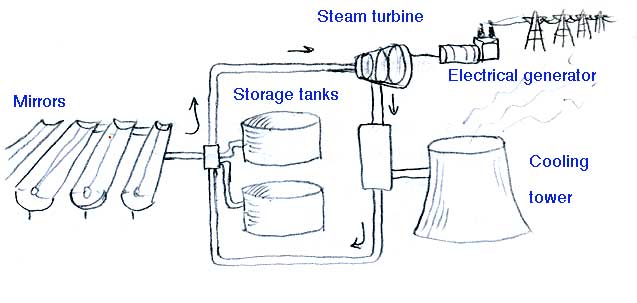
^Diagram of Solar Millennium's planned project with thermal storage tanks to store heat generated from the sun.
It will be interesting to see how these thermal storage tanks work, as Solar Millennium's website says they have only been used in the test research facility Andasol 1, 2, and 3 in Spain. Don Reid, senior project development advisor, told us theoretically the tanks can store heat and thus provide electricity all night, but that in this project they will only store heat for three and a half hours after sunset when NV Energy (the purchasing utility) says a peak in electricity use occurs.
The parabolic mirrors gather the sun's heat in pipes containing Thermanol, a synthetic oil, and the heat is then transferred to molten salt in the storage tanks, a new technology. Jessie Audette, VP in project development, told us that in the future they may use molten salt directly in the mirror emasculating tubes. New technologies are being developed with the cooperation the the EPA. Reid proudly told us how the mirrors that will be used are larger than former projects, almost 60 feet long, dwarfing people standing next to them, and this increases efficiency further (see Solar Millennium's website and take a look at the photos of the gigantic parabolic mirrors at Andasol 1 in Spain, the template for the Amargosa project). The mirrors would be much larger than those currently used at Solar 1 Nevada near Boulder City.
3,000 acre-feet of water will be needed per year to cool the system after steam generation. The water is lost by evaporation from the cooling towers. (In contrast, the Ivanpah Solar Project in California will use a dry-cooling system consisting of several large towers with fans to air-cool the water in the pipes, a less efficient method, but one forced by lack of water in the desert.)
The small wooden power-poles presently in the town of Amargosa Valley would have to be upgraded to larger transmission lines (230 kilovolt) to tie into Valley Electric's substation, that would head to Pahrump.
Right now Solar Millennium is working with the BLM on their plan of development, and the environmental review process for the first stage of the project will occur this year and into 2010. If approved, construction would start in 2011 and operation by December 2013. Plant II would begin in 2015.
Solar Millennium hopes to receive a 30% federal grant for construction costs, and a 75% property tax abatement. The company claims that 800 construction jobs per 250 MW will be created, and 80 to 100 permanent jobs per 250 MW. "The local community will also benefit from additional jobs indirectly supported by ASPP," says a company leaflet at the open house.
Don Reid, in an off-guard moment, joked, "The sun is relatively free, but these plants are expensive to build!"
The right-of-way request by Solar Millennium amounts to 7,810 acres of BLM land, allowing for future expansion. Jessie Audette told us not to worry about the damage to the 4,350 acres of the first two project stages because it is "worthless desert habitat". "We found no tortoises," she said, and explained how off-roaders had done more damage to the land than their solar power plant ever would.
Ground Check
After the open house visit, we decided to check for ourselves if this land was "worthless desert." This spring had very uneven rainfall across the Mojave, with parts of Death Valley lush with wildflowers, but other areas dry. It was not a good annual year, but just enough winter rain soaked in to urge the deep-rooted shrubs to green-up and bloom.
Yellow flowers covered the Creosote (Larrea tridentata), and clumps of low Bursage (Ambrosia dumosa) dotted the flats of sand and gravel. Some saltbush (Atriplex polycarpa) grew in low silt pans. Dried wildflower stems from last year occupied areas in ghostly thin swaths. Harvester ant hills were dormant, but Zebra-tailed lizards (Callisaurus draconoides) skittered across the open areas.
We walked into the desert from Farm Road, right in the center in the proposed project, and again from Valley View Road into the side of the big square. One thing we always love about the desert is its quiet. Absolute silence. A few Black-throated sparrows sang from the creosote, and later at dusk the Lesser nighthawks purred as small bats darted about.
Big Dune rose off in the near distance, testament to the high winds that often rip across these flats. We found a few ventifacts, rocks carved into crested shapes by sand-blasting (we wondered what these winds will do to mirrors).

^Even in a dry year the Creosote will flower if s few good rains fell in winter. Center of the site of Solar Millennium's Amargosa power plant project along Farm Road.

^Classic creosote-bursage desert on the project site looking toward the back of the Funeral Mountains in Death Valley National Park.
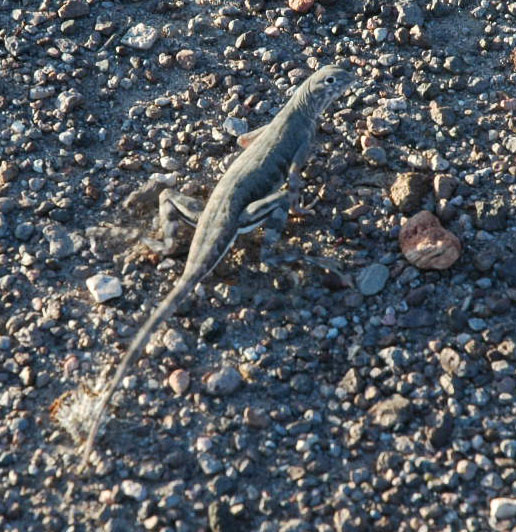
^We photographed this Zebra-tailed lizard on the site at sunset.
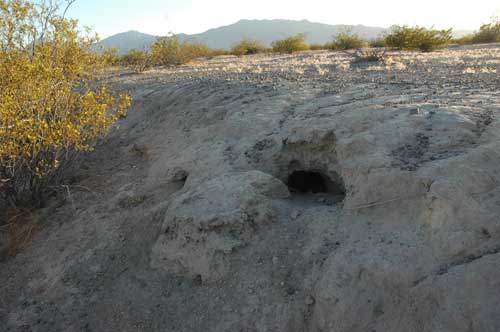
^Burrows of Kit foxes (Vulpes velox), kangaroo rats (Dipodomys spp.) and potential Desert tortoises (Gopherus agassizii) could also be found on the site. We will be interested to know when Solar Millennium's biologists surveyed the area for tortoises, as during a drought year they may remain underground and hidden most of the time.
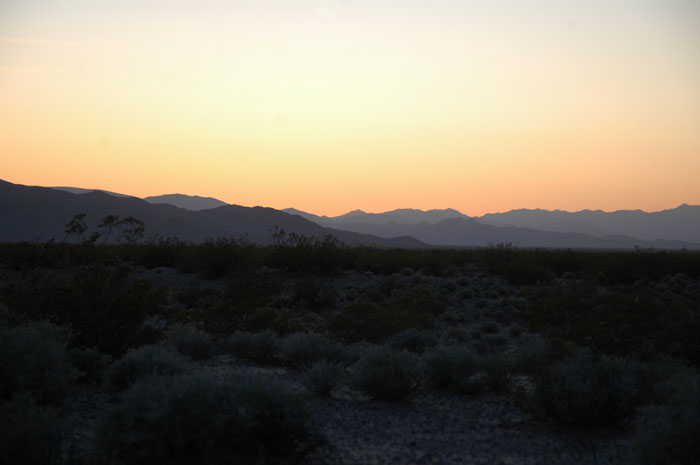
^The quiet desert at dusk, looking west towards Daylight Pass in Death Valley National Park.
Who's Water is it Anyway?
The day we visited the open house, Solar Millennium's Jessie Audette was so enthusiastic about building these plants that she told us that "all 3,000 acre feet of water have been acquired". When we told her we had not heard that, she assured us that many of the alfalfa farmers have agreed to sell them their water rights. Amargosa Valley has several alfalfa farms and even a dairy along the Amargosa River, which flows underground most of the year.
We called the Nevada State Engineer's office and were told that NONE of the water rights were transferred or even applied for yet. Because all of the water in Amargosa Valley is over- appropriated by 18,000 acre-feet, the only water Solar Millennium can hope to acquire are existing water rights. Perhaps the general public is told a different story than the press, as Las Vegas Sun reporter Alexandra Berzon told us she heard on a different day of the open house that the company was still negotiating with farmers to transfer water rights. In Nevada, an industry may only acquire 66% of agricultural water rights because hydrologists assume a portion of irrigation water will go back into the ground; a wet-cooled solar thermal power plant will lose all water it pumps from the aquifer.
We asked Audette about the 66% rule. How would Solar Millennium hope to get so much water from farms? They would just have to get more water rights to make up for this, she said.
Solar Millennium wants to use the existing farm wells and build a pipeline to their plant. In this plan, the company seeks to use no new net water withdrawal from the basin. "3,000 acre-feet of water is about the same used in a 600 acre alfalfa field," Audette reassured us. It remains to be seen how many farmers will sell out.
Water issues are going to come up concerning the nearby Devil's Hole pupfish, Ash Meadows National Wildlife Refuge, and the Amargosa River, as well as for the alfalfa farmers.
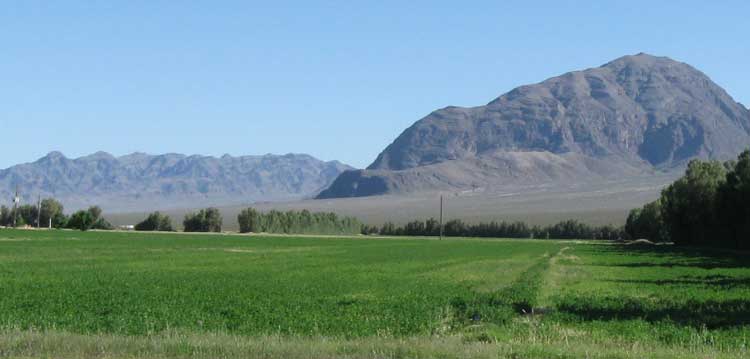
^Alfalfa fields on Farm Road, Amargosa Valley.
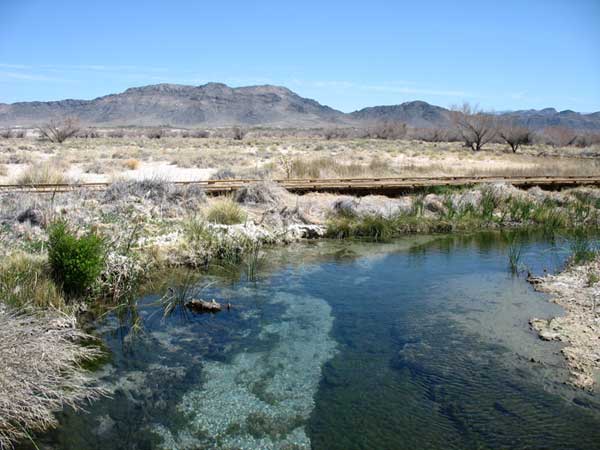
^What's at stake: springwaters of Ash Meadows National Wildlife Refuge with pupfish.
Bad PR
From confusion about water rights, to more public relations ploys, as the crowd ebbed, Jesse Audette and Don Reid hovered about us as we looked at a short video showing the construction of their Spanish solar project. Audette volunteered the usual numbers about how many houses would be served by this new facility, as well as how only three such solar thermal plants built in the California desert would give more energy than all rooftop solar panels in Arnold Schwarzenegger's "million roof' initiative.
But briefly recalling the numbers, this does not make sense: the Million Solar Roofs but comes in at 3,000 MW. Three solar thermal plants are almost certainly less than 1,000 (although they are trying to build an 850 MW one in California - Solar One). Most are well under 400 MW. In contrast democratic power production that could get 25,000 MW of power generated using Feed-In-Tariffs, power purchase agreements, and other creative rooftop solutions are off the table presently. (See >>here for more.)
Next, Audette explained to us how California will soon be placing a moratorium on construction of any new natural gas-burning power plants because of tough southern California air quality rules. "California will run out of energy," she declared, thus reinforcing the need to hurry up and build these solar plants in the desert. This seemed like strange propaganda, as there are many gas plants in all stages being built in California, and natural gas is one of the main baseload sources to support all the "green" power plants. We were not convinced. (See the Energy Information Administration for more on California's natural gas energy >>here.)
In Defense of OHVs
(Yes you read correctly.) Talk about calling the kettle black! Solar Millennium's Audette told us that off-roaders do more damage on site than their project would do. We went to the project site and found almost no tracks out onto the sand-gravel flats. We give credit to the OHV community for staying in the Big Dune OHV area.
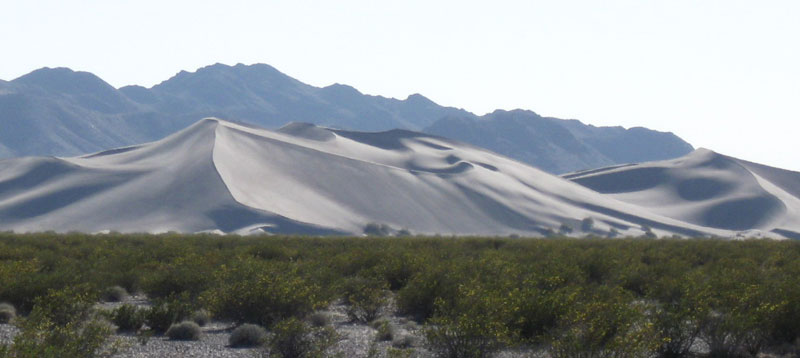
^Big Dune OHV area near the project site.
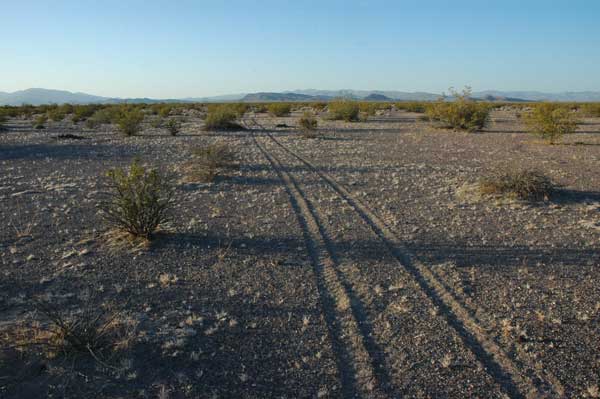
^We saw a few quad tracks across the site, but this temporary damage is nothing compared to a 100% scrape of all life to build an industrial power plant.
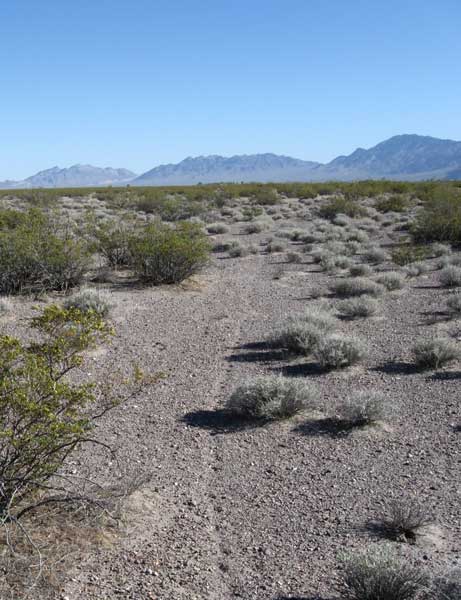
^One of the few other tracks we did see on the project site were a network of Coyote paths.
Worthless?
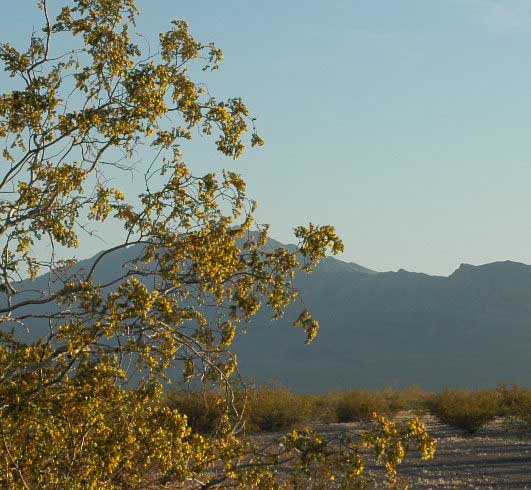
As Solar Millennium's Jesse Audette tried to win us over to their plan of desert destruction, she said how damaged the site is already by OHVs.
We replied that desert land is not worthless. Philosophically what is at stake is a lot of habitat that will be destroyed for a lot of wildlife, plants, and other BLM users.
"It is not a philosophical issue," Audette said, "but biological. Biologically it is worthless. We found no tortoises and no archaeological sites in our surveys."
We had to disagree. While this plot of Mojave Desert is not likely to be noticed by most conservation groups, it does support a healthy population of flora and fauna. It is scientifically inaccurate to call it "biologically worthless".
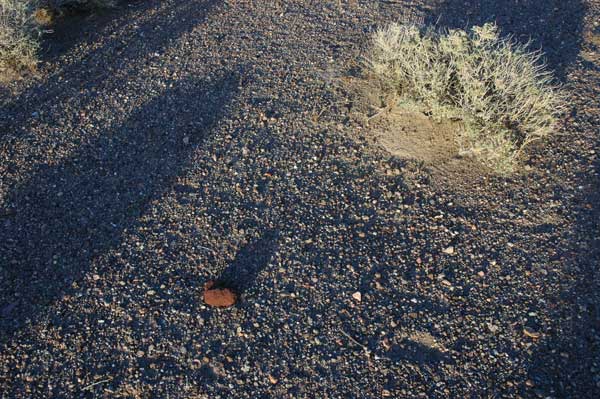
^The site had a scatter of red and black basaltic rocks thrown out by a group of cinder cones to the north hundreds to thousands of years ago.

^Biologically valuable land.

^We watched the sunset on site.
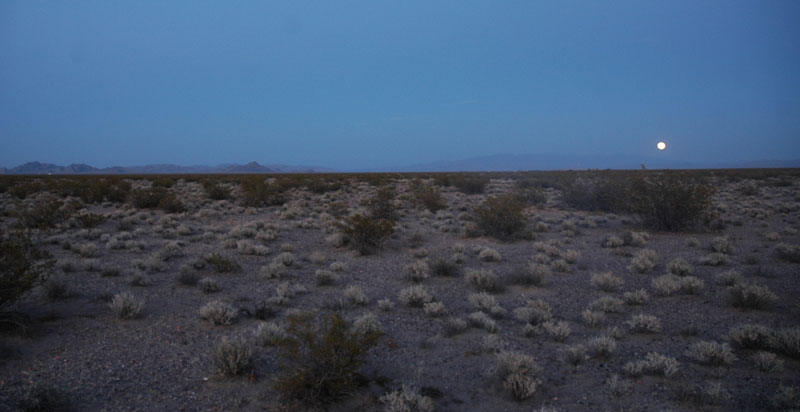
^Then the full moon rise over the Spring Range to the east.

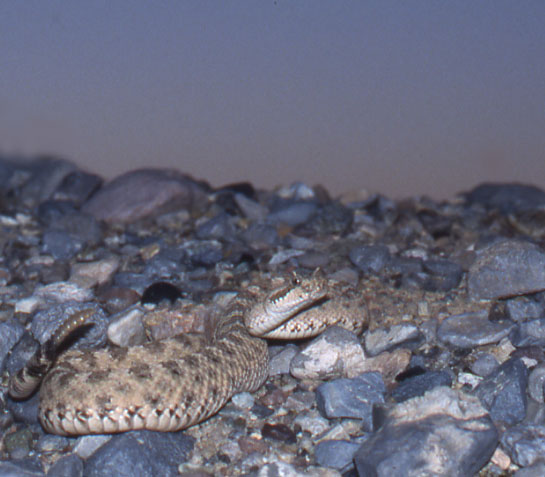
^We found Sidewinder tracks on the desert floor (Crotalus cerastes).
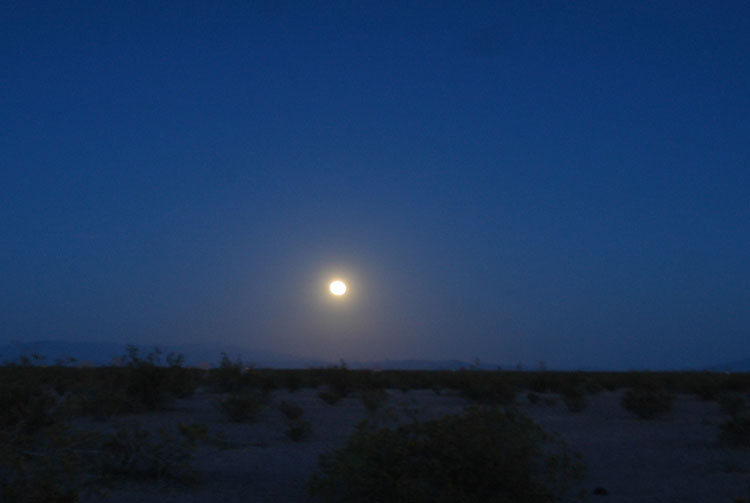
HOME.....Amargosa Desert.....Solar 1 Nevada.....Solar in the Desert.....The Problem...The Solution .....Amargosa Valley Cumulative Map of Solar and Wind Projects

